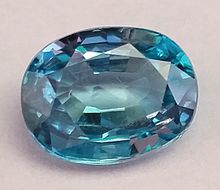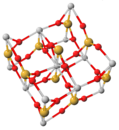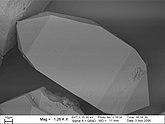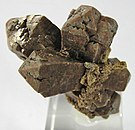Zircon
| Zircon | |
|---|---|
| References | [2][3][4][5][6] |
Zircon (
The name derives from the
Properties
Zircon is common in the
Because of their
Zircon occurs in many colors, including reddish brown, yellow, green, blue, gray, and colorless.
Structurally, zircon consists of parallel chains of alternating silica tetrahedra (silicon ions in fourfold coordination with oxygen ions) and zirconium ions, with the large zirconium ions in eightfold coordination with oxygen ions.[18]
Applications

Zircon is mainly consumed as an opacifier, and has been known to be used in the decorative ceramics industry.[19] It is also the principal precursor not only to metallic zirconium, although this application is small, but also to all compounds of zirconium including zirconium dioxide (ZrO2), an important refractory oxide with a melting point of 2,717 °C (4,923 °F).[20]
Other applications include use in refractories and foundry casting and a growing array of specialty applications as
Zircon is one of the key minerals used by geologists for geochronology.[22]
Zircon is a part of the ZTR index to classify highly-weathered sediments.[23]
Gemstone

Transparent zircon is a well-known form of semi-precious
Most gem-grade zircons show a high degree of birefringence which, on stones cut with a table and pavilion cuts (i.e., nearly all cut stones), can be seen as the apparent doubling-up of the latter when viewed through the former, and this characteristic can be used to distinguish them from diamonds and cubic zirconias (CZ) as well as soda-lime glass, none of which show this characteristic. However, some zircons from Sri Lanka display only weak or no birefringence at all, and some other Sri Lanka stones may show clear birefringence in one place and little or none in another part of the same cut stone.[26] Other gemstones also display birefringence, so while the presence of this characteristic may help distinguish a given zircon from a diamond or a CZ, it will not help distinguish it from, for example, a topaz gemstone. The high specific gravity of zircon, however, can usually separate it from any other gem and is simple to test.
Also, birefringence depends on the cut of the stone in relation to its optical axis. If a zircon is cut with this axis perpendicular to its table, birefringence may be reduced to undetectable levels unless viewed with a jeweler's loupe or other magnifying optics. The highest grade zircons are cut to minimize birefringence.[27]
The value of a zircon gem depends largely on its color, clarity, and size. Prior to World War II, blue zircons (the most valuable color) were available from many gemstone suppliers in sizes between 15 and 25 carats; since then, stones even as large as 10 carats have become very scarce, especially in the most desirable color varieties.[27]
Synthetic zircons have been created in laboratories.[28] They are occasionally used in jewellery such as earrings. Zircons are sometimes imitated by spinel and synthetic sapphire, but are not difficult to distinguish from them with simple tools.
Occurrence

Zircon is a common accessory to trace mineral constituent of all kinds of igneous rocks, but particularly granite and felsic igneous rocks. Due to its hardness, durability and chemical inertness, zircon persists in sedimentary deposits and is a common constituent of most sands.[29][30] Zircon can occasionally be found as a trace mineral in ultrapotassic igneous rocks such as kimberlites, carbonatites, and lamprophyre, owing to the unusual magma genesis of these rocks.[citation needed]
Zircon forms economic concentrations within
and armstrongite.Australia leads the world in zircon mining, producing 37% of the world total and accounting for 40% of world EDR (
Radiometric dating

Zircon has played an important role during the evolution of
Zircons from
Similar minerals
Hafnon (HfSiO4), xenotime (YPO4), béhierite, schiavinatoite ((Ta,Nb)BO4), thorite (ThSiO4), and coffinite (USiO4)[14] all share the same crystal structure (IVX IVY O4, IIIX VY O4 in the case of xenotime) as zircon.
Gallery
-
Crystal structure of zircon
-
Unit cell of zircon
-
Scanning electron microscope image of zircon
-
Unusual olive-green zircon
-
Cluster of three compound crystals of zircon
See also
- Baddeleyite, ZrO2
- Cathodoluminescence microscope
- Cool Early Earth
- Earliest known life forms
- Hadean zircon
- Heavy mineral sands ore deposits
- History of Earth
- Ilmenite
- Cerium anomaly
References
- S2CID 235729616.
- ^ ISBN 978-0962209710.
- ^ "Zircon: Mineral information, data and localities". Mindat.org. Retrieved October 19, 2021.
- ^ "Zircon Mineral Data". Webmineral. Retrieved October 19, 2021.
- ^ ISBN 0-471-80580-7.
- S2CID 67779734.
- CollinsDictionary.com. HarperCollins. Retrieved April 29, 2018.
- ^ "zircon". The American Heritage Dictionary of the English Language (5th ed.). HarperCollins.
- ^ "zircon". Merriam-Webster.com Dictionary. Retrieved April 29, 2018.
- ISBN 978-0-19-508083-4.
- ^ Harper, Douglas. "zircon". Online Etymology Dictionary.
- ^ "Hyacinth (gem)". Encyclopædia Britannica. Encyclopædia Britannica Inc. Retrieved October 7, 2016.
- ISBN 9780195106916.
- ^ S2CID 210256739– via Elsevier Science Direct.
- ^ Nesse 2000, pp. 93–94.
- ^ "Zircon gemstone information". www.gemdat.org. Retrieved April 29, 2018.
- .
- ^ Nesse 2000, p. 313.
- ISBN 978-3527306732.
- S2CID 120967147.
- ^ "Products". Mineral Commodities Ltd. Archived from the original on October 7, 2016. Retrieved August 8, 2016.
- ^ Nesse 2000, p. 314.
- ISBN 0136427103.
- ^ Brauns, Reinhard (1912). The Mineral Kingdom (Volume 1). Translated by Leonard James Spencer. J.F. Schreiber. p. 217.
- ^ Oliver Cummings Farrington (1903). Gems and Gem Minerals. A.W. Mumford. p. 109.
- ^ L.J. Spencer (1905). Report of the Seventy-Fourth Meeting of the British Association for the Advancement of Science. John Murray. pp. 562–563.
- ^ a b "Physical & Optical Properties of Zircon". Colored Gemstones Guide. Retrieved October 19, 2021.
- S2CID 102001496.
- ^ Nesse 2000, pp. 313–314.
- ^ Hurlbut & Klein 1985, p. 454.
- ^ Staff (June 2007). "Dubbo Zirconia Project Fact Sheet June 2014" (PDF). Alkane Resources Limited. Archived from the original (PDF) on February 28, 2008. Retrieved September 10, 2007.
- ^ "The Mineral Sands Industry Factbook" (PDF). Archived from the original (PDF) on August 18, 2016.
- ^ "Heavy Minerals Mining in Africa – Titanium And Zirconium". Archived from the original on May 28, 2008. Retrieved August 8, 2016.
- ^ "Zircons – Application Note". DELMIC. Retrieved February 10, 2017.
- hdl:10023/3575.
- ^ S2CID 4319774.
- S2CID 2819082.
- .
- S2CID 53118854.
- .
- ^ "Ancient mineral shows early Earth climate tough on continents". Physorg.com. June 13, 2008.
- .
- .
- doi:10.1038/ngeo2075.
- ^ a b Borenstein, Seth (October 19, 2015). "Hints of life on what was thought to be desolate early Earth". Excite. Yonkers, NY: Mindspark Interactive Network. Associated Press. Archived from the original on October 23, 2015. Retrieved October 8, 2018.
- PMID 26483481.
Further reading
- John M. Hanchar & Paul W. O. Hoskin, eds. (2003). "Zircon". Reviews in Mineralogy and Geochemistry (ISBN 0-939950-65-0.
- .
- A. N. Halliday (2001). "In the beginning…". Nature. 409 (6817): 144–145. S2CID 4339433.
- Hermann Köhler (1970). "Die Änderung der Zirkonmorphologie mit dem Differentiationsgrad eines Granits". Neues Jahrbuch für Mineralogie - Monatshefte. 9: 405–420.
- K. Mezger & E. J. Krogstad (1997). "Interpretation of discordant U-Pb zircon ages: An evaluation". Journal of Metamorphic Geology. 15 (1): 127–140. S2CID 129846813.
- J. P. Pupin (1980). "Zircon and Granite petrology". Contributions to Mineralogy and Petrology. 73 (3): 207–220. S2CID 96470918.
- Gunnar Ries (2001). "Zirkon als akzessorisches Mineral". Aufschluss. 52: 381–383.
- G. Vavra (1990). "On the kinematics of zircon growth and its petrogenetic significance: a cathodoluminescence study". Contributions to Mineralogy and Petrology. 106 (1): 90–99. S2CID 140566387.
- doi:10.1130/0091-7613(2002)030<0351:ACEE>2.0.CO;2. Archived from the originalon March 4, 2005. Retrieved April 11, 2005.
- G. Vavra (1994). "Systematics of internal zircon morphology in major Variscan granitoid types". Contributions to Mineralogy and Petrology. 117 (4): 331–344. S2CID 128459636.
External links
- Geochemistry of old zircons. Archived April 12, 2007, at the Wayback Machine.
- Mineral galleries (archived 7 April 2005)
- GIA Gem Encyclopedia – Zircon Online articles and information on zircon history, lore, and research
- Zircon Industry Association





